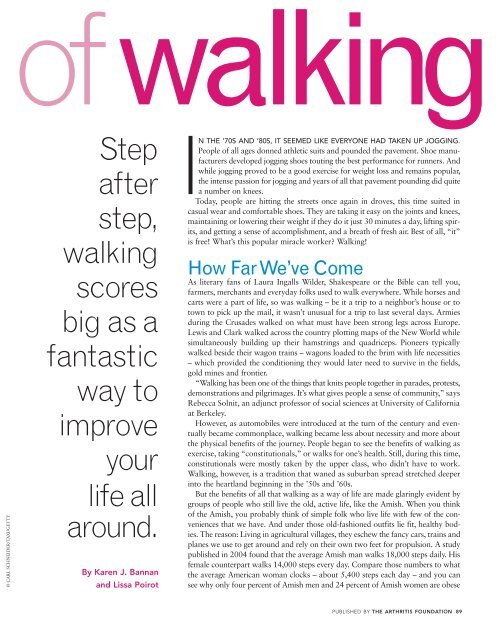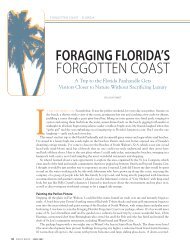The Wow of Walking - Lissa Poirot
The Wow of Walking - Lissa Poirot
The Wow of Walking - Lissa Poirot
You also want an ePaper? Increase the reach of your titles
YUMPU automatically turns print PDFs into web optimized ePapers that Google loves.
<strong>of</strong>walking<br />
© CARL SCHNEIDER/TAXI/GETTY<br />
Step<br />
after<br />
step,<br />
walking<br />
scores<br />
big as a<br />
fantastic<br />
way to<br />
improve<br />
your<br />
life all<br />
around.<br />
By Karen J. Bannan<br />
and <strong>Lissa</strong> <strong>Poirot</strong><br />
IN THE ’70S AND ’80S, IT SEEMED LIKE EVERYONE HAD TAKEN UP JOGGING.<br />
People <strong>of</strong> all ages donned athletic suits and pounded the pavement. Shoe manufacturers<br />
developed jogging shoes touting the best performance for runners. And<br />
while jogging proved to be a good exercise for weight loss and remains popular,<br />
the intense passion for jogging and years <strong>of</strong> all that pavement pounding did quite<br />
a number on knees.<br />
Today, people are hitting the streets once again in droves, this time suited in<br />
casual wear and comfortable shoes. <strong>The</strong>y are taking it easy on the joints and knees,<br />
maintaining or lowering their weight if they do it just 30 minutes a day, lifting spirits,<br />
and getting a sense <strong>of</strong> accomplishment, and a breath <strong>of</strong> fresh air. Best <strong>of</strong> all, “it”<br />
is free! What’s this popular miracle worker? <strong>Walking</strong>!<br />
How Far We’ve Come<br />
As literary fans <strong>of</strong> Laura Ingalls Wilder, Shakespeare or the Bible can tell you,<br />
farmers, merchants and everyday folks used to walk everywhere. While horses and<br />
carts were a part <strong>of</strong> life, so was walking – be it a trip to a neighbor’s house or to<br />
town to pick up the mail, it wasn’t unusual for a trip to last several days. Armies<br />
during the Crusades walked on what must have been strong legs across Europe.<br />
Lewis and Clark walked across the country plotting maps <strong>of</strong> the New World while<br />
simultaneously building up their hamstrings and quadriceps. Pioneers typically<br />
walked beside their wagon trains – wagons loaded to the brim with life necessities<br />
– which provided the conditioning they would later need to survive in the fields,<br />
gold mines and frontier.<br />
“<strong>Walking</strong> has been one <strong>of</strong> the things that knits people together in parades, protests,<br />
demonstrations and pilgrimages. It’s what gives people a sense <strong>of</strong> community,” says<br />
Rebecca Solnit, an adjunct pr<strong>of</strong>essor <strong>of</strong> social sciences at University <strong>of</strong> California<br />
at Berkeley.<br />
However, as automobiles were introduced at the turn <strong>of</strong> the century and eventually<br />
became commonplace, walking became less about necessity and more about<br />
the physical benefits <strong>of</strong> the journey. People began to see the benefits <strong>of</strong> walking as<br />
exercise, taking “constitutionals,” or walks for one’s health. Still, during this time,<br />
constitutionals were mostly taken by the upper class, who didn’t have to work.<br />
<strong>Walking</strong>, however, is a tradition that waned as suburban spread stretched deeper<br />
into the heartland beginning in the ’50s and ’60s.<br />
But the benefits <strong>of</strong> all that walking as a way <strong>of</strong> life are made glaringly evident by<br />
groups <strong>of</strong> people who still live the old, active life, like the Amish. When you think<br />
<strong>of</strong> the Amish, you probably think <strong>of</strong> simple folk who live life with few <strong>of</strong> the conveniences<br />
that we have. And under those old-fashioned outfits lie fit, healthy bodies.<br />
<strong>The</strong> reason: Living in agricultural villages, they eschew the fancy cars, trains and<br />
planes we use to get around and rely on their own two feet for propulsion. A study<br />
published in 2004 found that the average Amish man walks 18,000 steps daily. His<br />
female counterpart walks 14,000 steps every day. Compare those numbers to what<br />
the average American woman clocks – about 5,400 steps each day – and you can<br />
see why only four percent <strong>of</strong> Amish men and 24 percent <strong>of</strong> Amish women are obese<br />
PUBLISHED BY THE ARTHRITIS FOUNDATION 89







